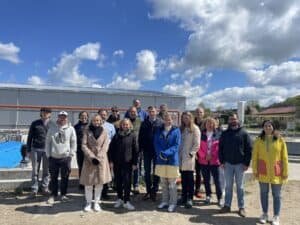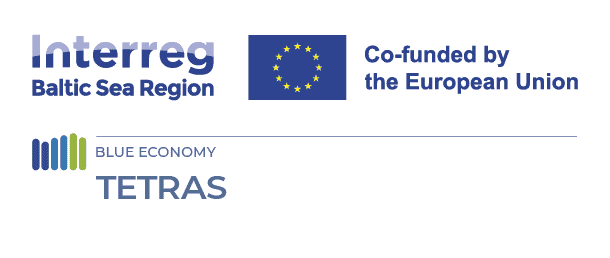
Driving Progress: TETRAS Partners Gather in Gdynia to Chart the Course for Sustainable Recirculating Aquaculture in the Baltic Sea Region
21 May 2024
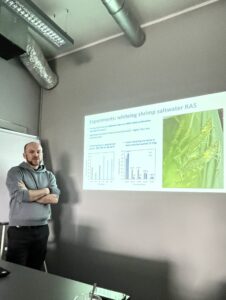
Nerijus Nikka from Klaipeda University shares updates on Pilot 2.
TETRAS is a three-year project co-financed by Interreg Baltic Sea Region. The project brings together ten partners from five different countries in the region to improve the environmental and economic performance of recirculating aquaculture systems (RAS) through new concepts of industrial symbiosis. This approach aims to increase resource use efficiency and promote food security while enhancing investment, implementation, and expansion of these food production systems in the Baltic Sea Region.
Partners from the ten organizations involved in the TETRAS project gathered at the Faculty of Oceanography and Geography of the University of Gdańsk on May 6 and 7, 2024. Over the two days, project partners discussed pilot updates, strengthened collaboration opportunities between pilots and partners, and paved the way ahead to achieve the project’s goals successfully.
Assessing Impact: Life Cycle Assessment (LCA) in RAS
As part of the project activities, specifically in Pilot 2 (geothermal resources) and Pilot 4 (small-scale RAS for social awareness), a life cycle assessment will be carried out. For this, the TETRAS team has the support of Lorenzo Rossi and his team from the University of Milan, Italy. LCA is a tool to assess the environmental impacts and resources used throughout a product’s life cycle. With alternative production systems like RAS, it is important to use LCA to compare and highlight the benefits of these systems over traditional ones and identify improvement opportunities.
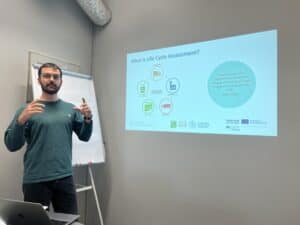
Lorenzo Rossi and his team from the University of Milan, Italy explained about LCA and how this tool can be used in RAS.
During the partner meeting, partners learned first-hand from Lorenzo about LCA in aquaculture and the approach taken by his team, and the specific data being collected for the TETRAS project. The group also discussed the challenges of carrying out LCAs and how best to present the results to external stakeholders, such as decision-makers and investors.
Polish Aquaculture Overview
Another highlight of the meeting was a presentation on the Polish aquaculture sector by Tomasz Kulikowski, from the National Marine Fisheries Research Institute (MIR-PIB) and a member of the Project Advisory Group (PAG) of TETRAS. Tomasz provided context on the evolutions of the Polish aquaculture sector, which currently supplies 4% of the national seafood in live weight equivalent, with carp and trout being the main species cultured. He also shared success stories, opportunities, and challenges for different types of aquaculture in Poland (earth ponds, flow-through farms, semi-RAS, and closed-RAS), comparing them in terms of species, number of farms, staff requirements, and other factors. One of the most interesting aspects was learning from other aquaculture sectors, such as the communication campaign by Polish carp producers to attract young consumers and the role of active producer organizations.
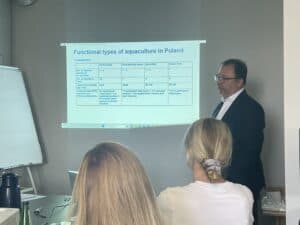
Tomasz Kulikowski, from the National Marine Fisheries Research Institute (MIR-PIB) shares the main characteristics of the different types of aquaculture in Poland.
Advancing Symbiosis: Insights from the Estonian Pilot and Feasibility Study
The Estonian Pilot (Pilot 3) of TETRAS is contributing to the development of the Estonian Symbiosis AgroPark (EISAP), with Ida-Viru Investment Agency (IVIA) leading its activities. To develop a comprehensive feasibility study for the early-stage development of the EISAP, IVIA partnered with Consultare OÜ, an experienced Estonian consultancy. Consultare OÜ is conducting a feasibility study to analyze the use of available resources (land, water, energy) at the EISAP and strategies for optimal water use and management in designing a commercial RAS farm in symbiosis with greenhouses. During the partner meeting, Kristo Kiiker and Kirstjan Piirimae from Consultare OÜ shared the scope and approach of this task and their progress. It was enlightening to understand all the factors considered in such studies, and the groups remained looking forward to seeing the progress of this study.
Exploring Innovation on the Ground: K1/K2 Site Visit
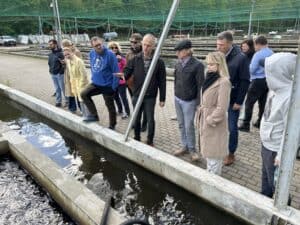
Marcin Juchniewicz from K1/K2 Trout Farm describing the water treatment process at the K1 facility.
What better way to complement the excellent discussions than with a visit to an aquaculture farm?
On the second day, Marcin Juchniewicz from K1/K2 Trout Farm welcomed the group to their facilities. The visit started at the K1 site, where rainbow trout is grown in tanks in semi-RAS with 80% water recirculation. The farm was renovated from a flow-through system to semi-RAS, allowing them to triple their production and overcome summer water shortages.
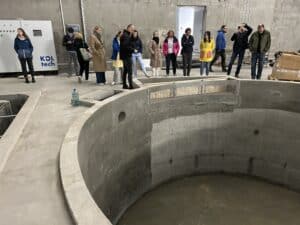
TETRAS partners at the K2 indoor facility.
Looking to diversify its products, the farm has two production types: one for trout fillets and another for trout egg caviar. Trout fillets are ready for harvest after 5-6 months, while those for caviar take about two years. The TETRAS team learned about the farm’s operation, water treatment process, monitory system, and the challenges of operating an aquaculture farm.
The group then visited the K2 site, a newly built AS facility aiming for 90-95% water recirculation. The timing was perfect, as the construction of the tanks and water treatment system had recently finished, with only the hatchery currently operating. Partners were able to see the facility and understand the system’s operation, looking forward to returning and seeing K2 fully operational.
Planning Ahead: Defining the Next Steps for TETRAS
The project is nearing its midpoint. During the first year, the focus was on preparing pilot activities, and in early 2024, the team began actively implementing them. With a year and a half ahead, and the most crucial part of the project coming, TETRAS partners had fruitful discussions on the next steps to navigate the second half smoothly and accomplish the set goals.
Stay tuned for further developments as exciting things lie ahead!
